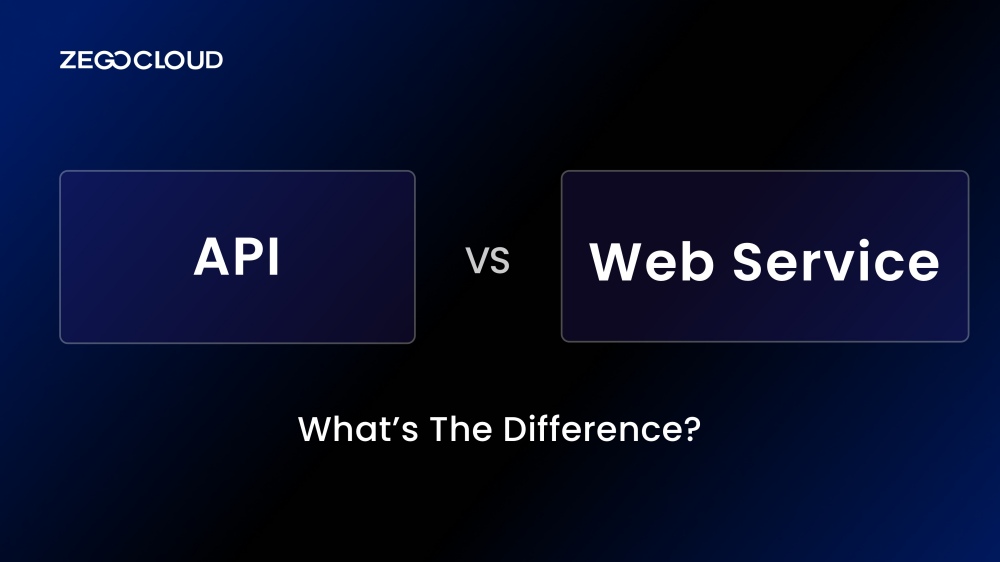API vs Web Service is a duel to understand, as they both are critical components of modern software architecture. A good developer knows although there is some overlap when using these two terms, they are not interchangeable. In this article, we’ll explain the differences between a web service and an API, as they serve different purposes depending on the needs of your software. But first, let’s dive into their definitions and characteristics.
What is API?
In a previous article, we discussed the concept and utility of APIs. An API, or Application Programming Interface, is a set of rules and protocols that allow different types of software to communicate with one another. It serves as a link between software systems, allowing them to exchange data and perform specific tasks. The API is a messenger, transporting data from one location to another. APIs are literally everywhere, and they come in all shapes and sizes.
Features and Advantages of APIs
Key API characteristics include efficiency and time effectiveness, customization, simple UI integration, extended reach, and data ownership.
There are multiple advantages when using APIs. First, APIs are convenient for developers since they require just a few lines of code to be added to their client apps. This is what ZEGOCLOUD solutions enable with their broad APIs offer.

API’s adaptability and scalability are essential to accommodate various client requirements and business projects. That’s why businesses considering implementing Web APIs ensure that API performance does not degrade with scale. They do so with methods like load-balancing and caching.
Control over a single Web API is easy. However, an API management framework is often designed to achieve control over APIs. This way, when companies use many APIs, the Web API designer can manage them together.
Tracking services and signaling unusual activities is another advantage of Web APIs. Protection from online assaults and security is, therefore, fundamental.
Further technical advantages that an API is:
- Strengthened connection
- Supporting the standard create, read, update, and delete (CRUD) operations and utilizing the HTTP PUT, POST, DELETE, and GET verbs
- Making service information available to browsers through HTTP, which you may configure and make RESTful.
Disadvantages of APIs
Nothing comes without drawbacks. So do APIs. The most relevant ones are:
- The time-consuming process of API creation requires talented resources.
- Programming knowledge is a must which leads to high costs of API maintenance.
- Boundary definition and delineation are vague and imprecise
- The necessity of a fixed scale
- Crashing can occur when testing Web APIs
In essence, APIs are online resources that developers and businesses could build up to offer more digital services to their clients. However, given the disadvantages, internal standards for integrating or coordinating applications might be preferable. Many prefer using APIs that aren’t always dependent on the HTTP protocol, thus, adopting more custom-built solutions.
What are Web Services?
Web services constitute a set of open-source protocols and standards accessible over the Internet. They exchange data between systems or applications, mainly for REST, SOAP – the two most common forms of Web services – and XML-RPC communication. Web services only support the HTTP protocol. Their usefulness is providing features other apps may use among the most popular payment processing, logins, and database storage.
To perform complicated processes, Web services can be joined in a loosely connected manner. Programs offering basic services can communicate with one another to deliver more complex services with added value.
You may also like: Top 10 Types of Web Development Services
Features and Advantages of Web Services
Web services were developed to be used as requests for Web pages that help with data retrieval. Interoperability is the primary goal for developers, and Web services give different applications a way to link their data for this purpose. They serve as construction materials that make it simple to reuse web service components in various services.
Also, with Web services, a developer can integrate several functionalities into a product without coding them all from scratch. Using separate Web services, in fact, allows programs to interact together. Consequently, this leads to much time, resources, and energy saved.
The main features characterizing Web services are:
- High interoperability and extensibility
- Machine-processable descriptions made possible by the use of XML
- Autonomy so that every service exists separately from all other services
- Simple to use and agile
- In-loose coupling
- Support for remote procedure calls and sharing documents. Hence, quicker internal and external communications within businesses
Disadvantages of Web Service
Web services are excellent at solving some challenges but sometimes introduce new ones. Issues may arise due to the technological underpinnings of Web services or the specifications.
As we learned, Web services support only HTTP protocol. This latter is unreliable since it does not guarantee delivery or response time. Recent versions of the standard Web services allow protocols such as JMS to overcome this problem, but most services still use HTTP, which does not. Therefore, there is execution uncertainty. Consequently, the availability of Web services is a pain point, given the nature of their Internet infrastructure. Just like websites, they might be unavailable sometimes.
When there is a need for responses arising from client-customized machine needs, Web services are not helpful. Matching requirements might be challenging given their technology’s “one-size-fits-all” character.
So, to summarise the most widespread disadvantages of Web services:
- Emerging and advanced web technologies like Semantic Web and AJAX XML can not be used.
- The response is not guaranteed when submitting a request since HTTP is not very secure.
- Available through a network, making these services not useful for local communication.
- Inaccessibility through a browser may signal a broken Web service
- Specialization is a must when serving various clients, which can be time and resources consuming

Differences between Web Services and API
APIs and web services can ease data transfers between programs through the internet. However, they are different and should not be utilized interchangeably in all cases. Now that we have seen the two technologies’ general characteristics, let us tackle comparing API vs. Web service.
The primary distinction to bear is straightforward: all Web services are APIs, but not all are Web services. More precisely, Web services are a subset of APIs. As we mentioned when introducing the concept of APIs, this is a broad category, including any software component that serves as a bridge between two otherwise disparate applications. Consequently, a Web service is just a method of implementing an API.
More precisely, Web services are APIs accessible only via a network. APIs are application interfaces that do not need a network, allowing communication in any standardized manner.
In the following table, you can find the main differences between API and Web service.
| WEB SERVICE | API |
|---|---|
| For communication, it employs three styles: REST, SOAP, and XML-RPC. | It may be used to communicate in any way. |
| Only compatible with the HTTP protocol. | It supports the HTTP/s protocol, including URL Request/Response Headers. |
| Generally uses XML to exchange data. | Generally uses JSON to exchange data. It can still be used by a client who understands XML. |
| Does not come with a lightweight design, making it complex to employ for simple use cases. It requires SOAP protocol to send or receive data over the network. | Provides lightweight architecture that makes it easier to implement. |
| It requires the Internet to connect two or more software programs to different computers. | Does not necessitate the use of a network. For example, two programs on the same computer may still integrate via APIs. |
| Only accessible to approved partners. These online service owners have more control over data, performance, and who uses it. | It allows developers to experiment with them without control, while some are only available to paid clients. |
Unlocking Next-Gen API and Web Services with ZEGOCLOUD’s Communication SDK
For developers seeking comprehensive solutions in video calls, live streaming, and chat functionalities, ZEGOCLOUD offers a robust SDK that caters to a wide array of applications. With its versatile API, ZEGOCLOUDd seamlessly integrates with web platforms, as well as popular frameworks like Flutter and React Native, ensuring broad compatibility and ease of use.
Additionally, ZEGOCLOUD UIKits offers a suite of unified communication solutions, simplifying the integration of video, voice, and chat functionalities into apps and services. Designed for developers, these kits provide customizable, scalable options for enhancing user engagement across platforms.

Whether you’re building for web or mobile, ZEGOCLOUD’s SDK provides high-quality, real-time communication features that are essential for creating engaging user experiences in today’s interconnected digital world. Its standout feature is the ability to deliver smooth, low-latency interactions across various platforms, making it a top choice for developers aiming to implement reliable and efficient communication tools in their applications.
Conclusion
APIs and web services allow data to be sent across different software applications. APIs may be thought of as including but not limited to web services. Lightweight architecture makes APIs more widely available. They are an interface that exposes an application’s data to third-party software, and a Web service is one sort of API with stricter criteria. Among these criteria are the following:
- network connectivity
- SOAP, as the principal protocol,
- limited public accessibility.
While these definitions may appear somewhat complicated, understanding the slight but fundamental distinctions across web technologies is critical. Although there are subtle distinctions between these two notions, distinguishing them is crucial to better-comprehending product integrations.
Read More:
FAQ API vs Web Service
Q1: What is the difference between a web service and an API?
A web service is a specific type of API that operates over the web and enables two machines to communicate over a network. An API (Application Programming Interface) is a broader term that represents any interface or software intermediary allowing two applications to interact, whether over the web or not.
Q2: Can all APIs be considered web services?
No, not all APIs are web services. While all web services are APIs, not all APIs are web services. APIs include any software interface that allows applications to interact, whereas web services specifically refer to APIs that communicate over the web using protocols like HTTP.
Q3: What are the main types of web services?
The main types of web services are SOAP (Simple Object Access Protocol) and REST (Representational State Transfer). SOAP is a protocol-based web service with strict standards, while REST is an architectural style that uses HTTP requests to communicate and is considered more flexible and lightweight.
Q4: How does REST differ from SOAP in web service implementation?
REST, being an architectural style, uses standard HTTP methods and is stateless, making it faster and more scalable. SOAP, on the other hand, is a protocol that requires more bandwidth and is considered more secure and reliable, making it suitable for complex transactions. REST is typically easier to work with and preferred for web services requiring wide compatibility.
Q5: Why would a developer choose a web service over a direct API call within the same system?
A developer might choose a web service for inter-system communication to ensure compatibility and scalability over the web, leveraging standardized protocols like HTTP. Web services are designed for network-based requests, making them ideal for distributed systems, whereas direct API calls might be used for internal communications within the same system where network overhead is not a concern.
Let’s Build APP Together
Start building with real-time video, voice & chat SDK for apps today!










